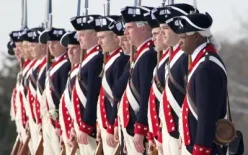 MOUNT VERNON, VA – The Blue Room in the Mount Vernon Mansion will reopen October 7, marking the completion of a major seven-month restoration. Guided by new research and investigation, this bedchamber’s dramatic transformation includes reproduction French wallpaper, cream-painted woodwork, and a bedstead draped in a striking blue-printed cotton.
MOUNT VERNON, VA – The Blue Room in the Mount Vernon Mansion will reopen October 7, marking the completion of a major seven-month restoration. Guided by new research and investigation, this bedchamber’s dramatic transformation includes reproduction French wallpaper, cream-painted woodwork, and a bedstead draped in a striking blue-printed cotton.
As the first room at the head of the stairs on the second floor, the Blue Room introduces modern-day visitors to the richly-furnished interiors experienced by the Washingtons’ guests. Its architecture and furnishings represent more than forty-years of personal and cultural change experienced by the Washingtons, and the furnishings in particular highlight Mrs. Washington’s influence in the home.
“The Blue Room provides us with a vibrant new look at the Washingtons,” said Susan P. Schoelwer, Mount Vernon’s Robert H. Smith Senior Curator. “It speaks to George Washington’s fascination with the technological advances of the day, and brings to the forefront Mrs. Washington’s importance in the development of Mount Vernon through the furnishings that she influenced. The ongoing research of the Historic Preservation and Collections staff shows that we still have so much to learn about the house and its inhabitants.”
In the 18th century, rooms were often named after the color of their textiles, and “Blue Rooms” figured prominently in upper-class homes on both sides of the Atlantic. The Mount Vernon room was mentioned by this name in a 1796 memo from George Washington’s farm manager, as well as in both Washingtons’ highly descriptive probate inventories, from 1800 and 1802.
Over the past seven months, Mount Vernon’s experts have restored the room’s existing architecture, finishes on the  woodwork and walls, and furnishings with the goal of giving Mount Vernon’s one million annual visitors a complete view of the interior as it looked in Washington’s day.
woodwork and walls, and furnishings with the goal of giving Mount Vernon’s one million annual visitors a complete view of the interior as it looked in Washington’s day.
Research and investigation by Mount Vernon’s architecture team uncovered the story of the room’s evolution from 1734 to today. Beginning as a garret room with sloping ceilings, the space was expanded in 1758 to the full-height room it is today. Within the north wall, the team identified a now-closed doorway, which led to a porch on the roof of an addition to the Mansion that stood from 1758 to 1776.
Further discoveries helped restore the fireplace to its 1799 appearance. The fireplace mantel had been removed from the Blue Room in the early 1980s, when it was suspected to be a 19th-century addition. Paint analysis confirmed the mantel to be the one that was installed in 1776. The team also found both physical and documentary evidence that Washington had upgraded to a more-efficient Rumford fireplace after the Presidency. This previously missing architectural feature was rebuilt.
 New paint analysis also revealed the woodwork in the room was cream-colored in the 1790s, rather than the blue seen from the 1980s to early 2017. Further research indicated that wallpaper adorned the walls during the 1790s, complementing the room’s blue textiles. A reproduction wallpaper replicates a floral pattern from the premier French firm of Jacquemart et Bénard. It is similar to what the Washingtons and other elite Americans were purchasing in the period, and it was hung using traditional methods.
New paint analysis also revealed the woodwork in the room was cream-colored in the 1790s, rather than the blue seen from the 1980s to early 2017. Further research indicated that wallpaper adorned the walls during the 1790s, complementing the room’s blue textiles. A reproduction wallpaper replicates a floral pattern from the premier French firm of Jacquemart et Bénard. It is similar to what the Washingtons and other elite Americans were purchasing in the period, and it was hung using traditional methods.
Although none of the room’s original furnishings have survived, Mount Vernon’s curatorial team carefully combed the Washingtons’ purchase records and probate inventories to understand how the furnishings for the Blue Room would have appeared in 1799. The focal point of the room is a four-post bedstead draped in a cotton fabric printed in indigo blue with life-like pairs of ducks and roosters amid bold swags of blossoms and fruit. Mount Vernon was fortunate to acquire six English period mahogany chairs to represent the six listed on the probate inventory.
For a limited time, visitors will also have the chance to see in the room a rare 18th-century print with a Washington family history, newly-restored and on loan from the Mary Washington House in Fredericksburg, Virginia. Nymphs Bathing, a classically-inspired landscape scene, is a remarkable example of early color-printing technologies. Washington hung a color print of Nymphs Bathing in the Blue Room in 1797, along with three additional fine prints he had recently acquired in Philadelphia. Reproductions of the landscape prints owned by the Washingtons will also be on view.
The Connoisseur Society of George Washington’s Mount Vernon sponsored the Blue Room restoration. Scott and Lynn Molitor, Jacqueline B. Mars, and more than 600 additional contributors from across the country also supported this project. The set of six English chairs was purchased with funds provided by the Christine and Jaime Yordán Foundation.
Please visit mountvernon.org/blueroom for additional details.
###


